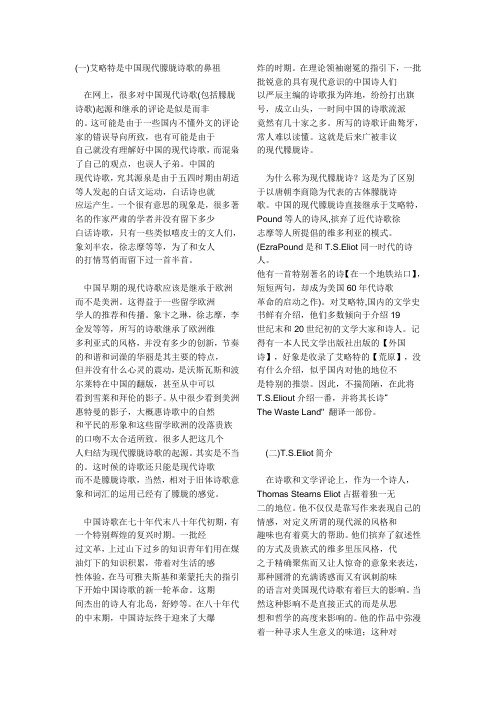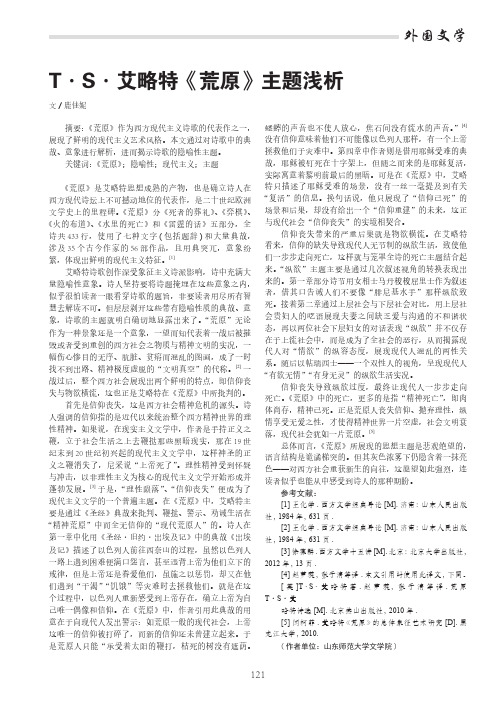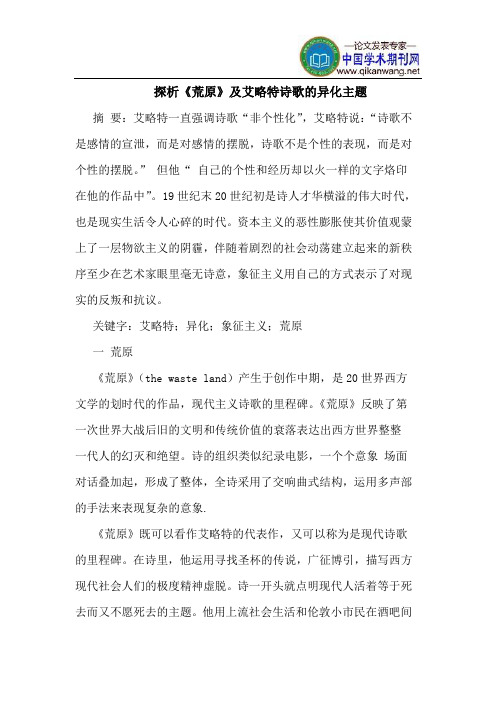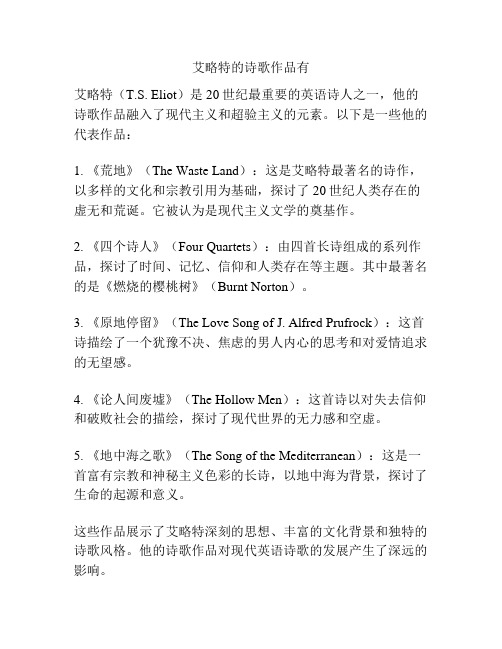The Wasteland of T.S.Eliot【艾略特长诗《荒原》的主旨+背景+框架+内容的概括分析】(全英文)
艾略特《荒原》主要内容概要及赏析

艾略特《荒原》主要内容概要及赏析(最新版)编制人:__________________审核人:__________________审批人:__________________编制单位:__________________编制时间:____年____月____日序言下载提示:该文档是本店铺精心编制而成的,希望大家下载后,能够帮助大家解决实际问题。
文档下载后可定制修改,请根据实际需要进行调整和使用,谢谢!并且,本店铺为大家提供各种类型的经典范文,如诗歌散文、原文赏析、读书笔记、经典名著、古典文学、网络文学、经典语录、童话故事、心得体会、其他范文等等,想了解不同范文格式和写法,敬请关注!Download tips: This document is carefully compiled by this editor.I hope that after you download it, it can help you solve practical problems. The document can be customized and modified after downloading, please adjust and use it according to actual needs, thank you!In addition, this shop provides you with various types of classic sample essays, such as poetry and prose, original text appreciation, reading notes, classic works, classical literature, online literature, classic quotations, fairy tales, experience, other sample essays, etc. if you want to know the difference Please pay attention to the format and writing of the sample essay!艾略特《荒原》主要内容概要及赏析【导语】:《荒原》外国文学作品简析英国诗人艾略特(18881965)的代表作,被誉为现代主义诗歌的里程碑。
艾略特的诗歌作品有

艾略特的诗歌作品有
摘要:
1.艾略特的诗歌作品概述
2.艾略特诗歌的主题与风格
3.艾略特诗歌的影响与评价
正文:
艾略特(T.S.Eliot) 是20 世纪最伟大的诗人之一,他的诗歌作品广泛涵盖现代主义文学的各个方面。
以下是他的一些著名的诗歌作品:
1.《荒原》(The Waste Land)
2.《普鲁弗洛克的恋歌》(The Love Song of J.Alfred Prufrock)
3.《夜莺颂》(Ode to the Nightingale)
4.《荒原》(The Hollow Men)
5.《教堂的谋杀》(Murder in the Cathedral)
6.《四个四重奏》(Four Quartets)
艾略特的诗歌主题广泛,包括人类的孤独、文明的崩溃、宗教信仰的危机、人类生命的无意义等等。
他的诗歌风格独特,采用了许多复杂的语言技巧,如隐喻、象征、荒诞性等等。
艾略特的诗歌作品对20 世纪文学产生了深远的影响,被誉为现代主义文学的代表作之一。
艾略特荒原中英对照

(一)艾略特是中国现代朦胧诗歌的鼻祖在网上,很多对中国现代诗歌(包括朦胧诗歌)起源和继承的评论是似是而非的。
这可能是由于一些国内不懂外文的评论家的错误导向所致,也有可能是由于自己就没有理解好中国的现代诗歌,而混枭了自己的观点,也误人子弟。
中国的现代诗歌,究其源泉是由于五四时期由胡适等人发起的白话文运动,白话诗也就应运产生。
一个很有意思的现象是,很多著名的作家严肃的学者并没有留下多少白话诗歌,只有一些类似嘻皮士的文人们,象刘半农,徐志摩等等,为了和女人的打情骂俏而留下过一首半首。
中国早期的现代诗歌应该是继承于欧洲而不是美洲。
这得益于一些留学欧洲学人的推荐和传播。
象卞之琳,徐志摩,李金发等等,所写的诗歌继承了欧洲维多利亚式的风格,并没有多少的创新,节奏的和谐和词澡的华丽是其主要的特点,但并没有什么心灵的震动,是沃斯瓦斯和波尔莱特在中国的翻版,甚至从中可以看到雪莱和拜伦的影子。
从中很少看到美洲惠特曼的影子,大概惠诗歌中的自然和平民的形象和这些留学欧洲的没落贵族的口吻不太合适所致。
很多人把这几个人归结为现代朦胧诗歌的起源。
其实是不当的。
这时候的诗歌还只能是现代诗歌而不是朦胧诗歌,当然,相对于旧体诗歌意象和词汇的运用已经有了朦胧的感觉。
中国诗歌在七十年代末八十年代初期,有一个特别辉煌的复兴时期。
一批经过文革,上过山下过乡的知识青年们用在煤油灯下的知识积累,带着对生活的感性体验,在马可雅夫斯基和莱蒙托夫的指引下开始中国诗歌的新一轮革命。
这期间杰出的诗人有北岛,舒婷等。
在八十年代的中末期,中国诗坛终于迎来了大爆炸的时期。
在理论领袖谢冕的指引下,一批批锐意的具有现代意识的中国诗人们以严辰主编的诗歌报为阵地,纷纷打出旗号,成立山头,一时间中国的诗歌流派竟然有几十家之多。
所写的诗歌讦曲骜牙,常人难以读懂。
这就是后来广被非议的现代朦胧诗。
为什么称为现代朦胧诗?这是为了区别于以唐朝李商隐为代表的古体朦胧诗歌。
中国的现代朦胧诗直接继承于艾略特,Pound等人的诗风,摈弃了近代诗歌徐志摩等人所提倡的维多利亚的模式。
T·S·艾略特《荒原》主题浅析

外国文学T·S·艾略特《荒原》主题浅析文/鹿佳妮摘要:《荒原》作为西方现代主义诗歌的代表作之一,展现了鲜明的现代主义艺术风格。
本文通过对诗歌中的典故、意象进行解析,进而揭示诗歌的隐喻性主题。
关键词:《荒原》;隐喻性;现代主义;主题《荒原》是艾略特思想成熟的产物,也是确立诗人在西方现代诗坛上不可撼动地位的代表作,是二十世纪欧洲文学史上的里程碑。
《荒原》分《死者的葬礼》、《弈棋》、《火的布道》、《水里的死亡》和《雷霆的话》五部分,全诗共433行,使用了七种文字(包括题辞)和大量典故,涉及35个古今作家的56部作品,且用典突兀,意象纷繁,体现出鲜明的现代主义特征。
[1]艾略特诗歌创作深受象征主义诗派影响,诗中充满大量隐喻性意象。
诗人坚持要将诗题掩埋在这些意象之内,似乎很怕读者一眼看穿诗歌的题旨,非要读者用尽所有智慧去解读不可。
但层层剥开这些带有隐喻性质的典故、意象,诗歌的主题就明白确切地显露出来了。
“荒原”无论作为一种景象还是一个意象,一望而知代表着一战后被摧毁或者受到重创的西方社会之物质与精神文明的实况,一幅伤心惨目的无序、肮脏、贫瘠而混乱的图画,成了一时找不到出路、精神极度虚脱的“文明真空”的代称。
[2]一战过后,整个西方社会展现出两个鲜明的特点,即信仰丧失与物欲横流,这也正是艾略特在《荒原》中所批判的。
首先是信仰丧失,这是西方社会精神危机的源头。
诗人强调的信仰指的是近代以来统治整个西方精神世界的理性精神。
如果说,在现实主义文学中,作者是手持正义之鞭,立于社会生活之上去鞭挞那些黑暗现实,那在19世纪末到20世纪初兴起的现代主义文学中,这样神圣的正义之鞭消失了,尼采说“上帝死了”。
理性精神受到怀疑与冲击,以非理性主义为核心的现代主义文学开始形成并蓬勃发展。
[3]于是,“理性陨落”、“信仰丧失”便成为了现代主义文学的一个普遍主题。
在《荒原》中,艾略特主要是通过《圣经》典故来批判、鞭挞、警示、劝诫生活在“精神荒原”中而全无信仰的“现代荒原人”的。
探析《荒原》及艾略特诗歌的异化主题

探析《荒原》及艾略特诗歌的异化主题摘要:艾略特一直强调诗歌“非个性化”,艾略特说:“诗歌不是感情的宣泄,而是对感情的摆脱,诗歌不是个性的表现,而是对个性的摆脱。
”但他“自己的个性和经历却以火一样的文字烙印在他的作品中”。
19世纪末20世纪初是诗人才华横溢的伟大时代,也是现实生活令人心碎的时代。
资本主义的恶性膨胀使其价值观蒙上了一层物欲主义的阴霾,伴随着剧烈的社会动荡建立起来的新秩序至少在艺术家眼里毫无诗意,象征主义用自己的方式表示了对现实的反叛和抗议。
关键字:艾略特;异化;象征主义;荒原一荒原《荒原》(the waste land)产生于创作中期,是20世界西方文学的划时代的作品,现代主义诗歌的里程碑。
《荒原》反映了第一次世界大战后旧的文明和传统价值的衰落表达出西方世界整整一代人的幻灭和绝望。
诗的组织类似纪录电影,一个个意象场面对话叠加起,形成了整体,全诗采用了交响曲式结构,运用多声部的手法来表现复杂的意象.《荒原》既可以看作艾略特的代表作,又可以称为是现代诗歌的里程碑。
在诗里,他运用寻找圣杯的传说,广征博引,描写西方现代社会人们的极度精神虚脱。
诗一开头就点明现代人活着等于死去而又不愿死去的主题。
他用上流社会生活和伦敦小市民在酒吧间的谈论对比,证明两者都没有丝毫的意义,人们只是在欲火中煎熬而已。
接着艾略特用“淹死水中而后复生”的传说号召人民皈依天生,以求死而复活。
作为象征主义的代表作品,《荒原》在象征手法上的使用是极为丰富和出色的。
诗人不是简单零碎地使用一些象征,而是有组织的使用一系列的象征意象,使其成为表情达意的主要工具。
例如《荒原》第三章火诫中的一段:在那暮色苍茫的时刻,眼与背脊从桌边向上抬时,这血肉制成的引擎在等候像一辆出租汽车那样颤动而等候时……一个长疙瘩的青年到了,她“厌倦又疲乏”,冷漠的听任他发泄。
在那之后:她回头在镜子里照了一下,没大意识到她那已经走了的情人;她的头脑容许一个半成形的思想经过:……这里作者对现代让人有欲无情的厌恶并不是通过声色俱厉地抨击直接表现出来,而是思想寓于形象之中,情感寓于场景之中。
艾略特的诗歌作品有

艾略特的诗歌作品有
艾略特(T.S. Eliot)是20世纪最重要的英语诗人之一,他的诗歌作品融入了现代主义和超验主义的元素。
以下是一些他的代表作品:
1. 《荒地》(The Waste Land):这是艾略特最著名的诗作,以多样的文化和宗教引用为基础,探讨了20世纪人类存在的虚无和荒诞。
它被认为是现代主义文学的奠基作。
2. 《四个诗人》(Four Quartets):由四首长诗组成的系列作品,探讨了时间、记忆、信仰和人类存在等主题。
其中最著名的是《燃烧的樱桃树》(Burnt Norton)。
3. 《原地停留》(The Love Song of J. Alfred Prufrock):这首诗描绘了一个犹豫不决、焦虑的男人内心的思考和对爱情追求的无望感。
4. 《论人间废墟》(The Hollow Men):这首诗以对失去信仰和破败社会的描绘,探讨了现代世界的无力感和空虚。
5. 《地中海之歌》(The Song of the Mediterranean):这是一首富有宗教和神秘主义色彩的长诗,以地中海为背景,探讨了生命的起源和意义。
这些作品展示了艾略特深刻的思想、丰富的文化背景和独特的诗歌风格。
他的诗歌作品对现代英语诗歌的发展产生了深远的影响。
thewasteland简介

"The Waste Land"(《荒原》)是由美国诗人T.S.艾略特(T.S. Eliot)于1922年发表的一首诗歌作品。
这首诗歌被认为是20世纪最重要的文学作品之一,被广泛认为是现代主义文学的代表作品。
《荒原》以其复杂的结构、多层次的意象和深刻的哲学思考而闻名。
它反映了艾略特对当时社会和人类精神状态的深刻关注,以及对文化、宗教和历史的深刻反思。
这首诗歌融合了各种文学、宗教和历史的引用,表达了对现代社会的恐惧、对人类存在的困惑以及对文明衰落的担忧。
《荒原》被认为是一部充满象征主义和现代主义特征的杰作,对20世纪后世的文学和诗歌产生了深远的影响。
这首诗歌因其复杂的主题和语言而备受赞誉,被视为现代诗歌的经典之作。
艾略特荒原中英对照

(一)艾略特是中国现代朦胧诗歌的鼻祖在网上,很多对中国现代诗歌(包括朦胧诗歌)起源和继承的评论是似是而非的。
这可能是由于一些国内不懂外文的评论家的错误导向所致,也有可能是由于自己就没有理解好中国的现代诗歌,而混枭了自己的观点,也误人子弟。
中国的现代诗歌,究其源泉是由于五四时期由胡适等人发起的白话文运动,白话诗也就应运产生。
一个很有意思的现象是,很多著名的作家严肃的学者并没有留下多少白话诗歌,只有一些类似嘻皮士的文人们,象刘半农,徐志摩等等,为了和女人的打情骂俏而留下过一首半首。
中国早期的现代诗歌应该是继承于欧洲而不是美洲。
这得益于一些留学欧洲学人的推荐和传播。
象卞之琳,徐志摩,李金发等等,所写的诗歌继承了欧洲维多利亚式的风格,并没有多少的创新,节奏的和谐和词澡的华丽是其主要的特点,但并没有什么心灵的震动,是沃斯瓦斯和波尔莱特在中国的翻版,甚至从中可以看到雪莱和拜伦的影子。
从中很少看到美洲惠特曼的影子,大概惠诗歌中的自然和平民的形象和这些留学欧洲的没落贵族的口吻不太合适所致。
很多人把这几个人归结为现代朦胧诗歌的起源。
其实是不当的。
这时候的诗歌还只能是现代诗歌而不是朦胧诗歌,当然,相对于旧体诗歌意象和词汇的运用已经有了朦胧的感觉。
中国诗歌在七十年代末八十年代初期,有一个特别辉煌的复兴时期。
一批经过文革,上过山下过乡的知识青年们用在煤油灯下的知识积累,带着对生活的感性体验,在马可雅夫斯基和莱蒙托夫的指引下开始中国诗歌的新一轮革命。
这期间杰出的诗人有北岛,舒婷等。
在八十年代的中末期,中国诗坛终于迎来了大爆炸的时期。
在理论领袖谢冕的指引下,一批批锐意的具有现代意识的中国诗人们以严辰主编的诗歌报为阵地,纷纷打出旗号,成立山头,一时间中国的诗歌流派竟然有几十家之多。
所写的诗歌讦曲骜牙,常人难以读懂。
这就是后来广被非议的现代朦胧诗。
为什么称为现代朦胧诗?这是为了区别于以唐朝李商隐为代表的古体朦胧诗歌。
中国的现代朦胧诗直接继承于艾略特,Pound等人的诗风,摈弃了近代诗歌徐志摩等人所提倡的维多利亚的模式。
- 1、下载文档前请自行甄别文档内容的完整性,平台不提供额外的编辑、内容补充、找答案等附加服务。
- 2、"仅部分预览"的文档,不可在线预览部分如存在完整性等问题,可反馈申请退款(可完整预览的文档不适用该条件!)。
- 3、如文档侵犯您的权益,请联系客服反馈,我们会尽快为您处理(人工客服工作时间:9:00-18:30)。
T.S. ELIOT: THE WASTELANDThis poem was written for the most part while in a sanatorium in Lausanne in Switzerland recovering from nervous exhaustion (not the least cause of which was his marriage to Viv). A revolutionary poem both stylistically- and thematically-speaking, Pound described it as the ‘justification of our modern experiment, since 1900’. Although this is a difficult poem to sum up (the vastness of its scope has made some critics describe it as the epic of the Twentieth century and even Eliot conceptualised it as a collection of separate poems rather than one whole poem), there are a number of technical and thematic features which are worth noting.Formal Strategies:Heteroglossia / Montage:multiple voices succeed each other with alarming and bewildering rapidity. There is, notwithstanding a bizarre footnote crediting the figure of Tiresias with more importance in this respect than he has, no single, central speaker who unifies the multiplicity of perspectives offered in the poem. This is not a single dramatic monologue. Rather, many different chunks of the text (there are no clear demarcations) seem to be snatches (mini-monologues) uttered by different, individually recognisable personalities. At other times, there are passages seemingly uttered by oracular voices possessed of an almost visionary, prophetic, even Biblical quality (e.g. in the first and final sections). At other points, the voice is almost incantatory: e.g. the beginning where a speaker or perhaps a chorus of voices seems to lament the return of life in springtime.The Absence of a Traditional Narrative Development:no plot, no consistent flow of thought (logical or associational) to assist the reader in making sense of the poem. The effect of this accumulation of discontinuous voices is to release a flurry of implications whose swiftness and dense complexity make the poem difficult to apprehend, let alone digest. In short, this is a poem seemingly without coherence which simply begs the reader to unify it even as it denies the reader the normal means to do so: there simply is no continuity of setting, voice, narrative or style. In the place of these, one finds:Naturalistic Description:Eliot focuses for the most part on the more sordid and depressing details of the contemporary metropolis (such urban poetry represented a radical departure from the traditional focus on the natural landscape and on the agreeable, the beautiful and the ideal in Romantic poetry and its derivatives). The poem serves up something akin to a montage of visual images that explore city life and the lives of its inhabitants by juxtaposing images, scenes, dramatic vignettes containing fragments of conversation, etc. At times, these images assume an almost phantasmagoric dimension (e.g. “Unreal city”). Sordid urban images commingle with images of the desert/aridity to the point where, quite clearly, they are meant to comment upon each other: to wit, modern life in the city is being compared to an arid, sterile waste. Recurring Leitmotifs:these, in accumulating significance, become evocative symbols: these are scenes, images and allusions that are repeated in separate contexts and, by dint of which, assume symbolic resonance: e.g. hibernation, the desert; the rock; water; drowning (the allusions to the drowned Alonso in The Tempest, Ophelia’s suicide in Hamlet, a drowned Phoenician). As these motifs return in new contexts, they bring with them suggestions and associations from former contexts and evolve into “progressively denser nodes of connotation and feeling” (Perkins 504) and, in so doing, become symbols. This process also serves to link the diverse parts of the poem together. Eliot both draws upon established symbols and forges images into fresh symbols that include: fire (lust), death (this can sometimes mean literal death, sometimes the living death which these Wastelanders lead), rebirth, and water (arouses a mixture of longing [it quenches thirst], fascination and fear [death by drowning]).Recondite Allusions:these are to all sorts of other texts (at least 37) via deliberate echoes of and quotations drawn from other writers. Today, Postmodernists celebrate such pastiche and parody as the basis of all art but many critics of the era saw it as the effect of a lack of creativity. Is The Waste Land the quintessential Modernist/Postmodernist text?Mythological Framework:Eliot, influenced by Sir James Frazer’s The Golden Bough, implicitly alludes to the myth of the dying and reviving god which recurs throughout human civilisation. According to Frazer, primitive man explained the natural diurnal and annual cycles in terms of “the waxing or waning strength of divine beings” and the “marriage, the death and the rebirth of the gods” (qtd. in Perkins, 506). The king was regarded as an incarnation of the fertility of the land: if he weakened or died, the land wasted and would become fertile only when the king was once more healed, resurrected from the dead or succeeded. These ancient fertility myths were incorporated into Christianity. As Perkins puts it,the poem alludes repeatedly to primitive vegetation myths and associates them with theGrail legends and the story of Jesus. In the underlying myth of the poem the land is adry, wintry desert because the king is impotent or dead; if he is healed or resurrectedspring will return, bringing the waters of life. The myth coalesces with the quasi-naturalistic description of the modern, urban world, which is the dry, sterile land. . . . Thepoem does not tell the myths as stories but only alludes to them. . . . (506-7)Eliot’s mythological allusions introduces a semblance of an ordering framework or, for want of a better word, narrative into the poem:[w]hen one knows the plot, one can vaguely integrate some of the episodes of the poemwith it. The fable provides a third language, besides naturalistic presentation andsymbolism, in which the state of affairs can be conceived; the story of the sick king andsterile land is a concrete and imaginative way of speaking of the condition of man. (508)As Eliot put it in a commentary upon Joyce’s Ulysses, the whole apparatus of symbolic and mythological allusion together with the other related narrative techniques served as a way of ‘controlling, of ordering, of giving shape and significance to the immense panorama of futility and anarchy which is contemporary history.’ The possibility of regeneration signalled by the myth here may hint at Eliot’s growing interest in Christianity.Overview:The narrative strategies described above are not isolatable from each other. It is impossible to consider the use of symbolism, for example, apart from the use of leitmotifs or the mythological framework. In short, in this poem, the juxtaposition of diverse fragments and strategies serves to make them comment on each other,suggesting manifold, complex and diverse implications. Through symbolism multifariousassociations and connotations were evoked and complexly interwoven. The‘mythological method’ added levels of reference at every point. By allusion, Eliot . . .brought another context to bear on his own, and the parallels and contrasts might offer arich, indefinite ‘vista.’ (513)Some questions arise, though. For example, is The Wasteland one poem or is it several?Content / Themes:The Human Condition:This is summed up in the very title of the poem.Sexuality:The very nature of the myths alluded to has the effect of underscoring the sexual as the source of much of the horrors of life in this wasteland. It is perhaps not accidental that The Wasteland was composed and published in the heyday of Freudian thought. The Wasteland seems to have a special relationship in particular with Freud’s celebrated Civilisation and Its Discontents which was composed in the years leading up to 1930 and which was the crystallisation of much of Freud’s thinking up to this point. Freud’semphasis on the degree to which the harmony of human civilisation was merely a facade, predicated as it is upon the repression of the sexual drive and of aggression (his celebrated conflict between the so-called ‘reality’ and ‘pleasure principles’) is echoed in this poem in which sex, usually in some decadent and sullied form, is almost incessantly evoked (especially in sub-poems II and III). Sex is, indeed, the preoccupation of much of Eliot’s poetry. This is a poem which seems to identify the source of the deadening of moral life and the corruption of civilisation with a perversion of the act of procreation that is synonymous with life itself. This link between Frazer and Freud is directly addressed by Eliot who remarked once that The Golden Bough is a work “of no less importance for our time than the complementary work of Freud--throwing its light on the obscurities of the soul from a different angle”(qtd. in Perkins, 509).Dialectic of Form and Content:Marshall McLuhan once argued that sometimes the ‘medium is the message.’ This is of relevance, arguably, to The Wasteland: Perkins argues that “meanings are ambiguous, emotions ambivalent; the fragments do not make an ordered whole. But precisely this, the poem illustrates, is the human condition” (513). The poem conveys in one vignette after the other, the “sickness of the human spirit”(514), the “weakening of identity and will, of religious faith and moral confidence, the feelings of apathy, loneliness, helplessness, rootlessness, and fear” (514). Thepanoramic range and inclusiveness of the poem, which only Eliot’s fragmentary andelliptical juxtapositions could have achieved so powerfully in a brief work, held in onevision not only contemporary London and Europe but also human life stretching far backinto time. (514)Amidst this welter of confusion, people struggle to make sense of an existence which impedes every attempt to do so. Hence the appropriateness of the end where a “total disintegration is suggested in a jumble . . . of literary quotations” (514).。
